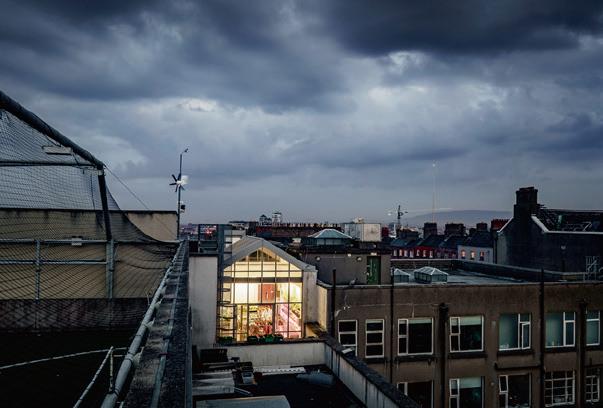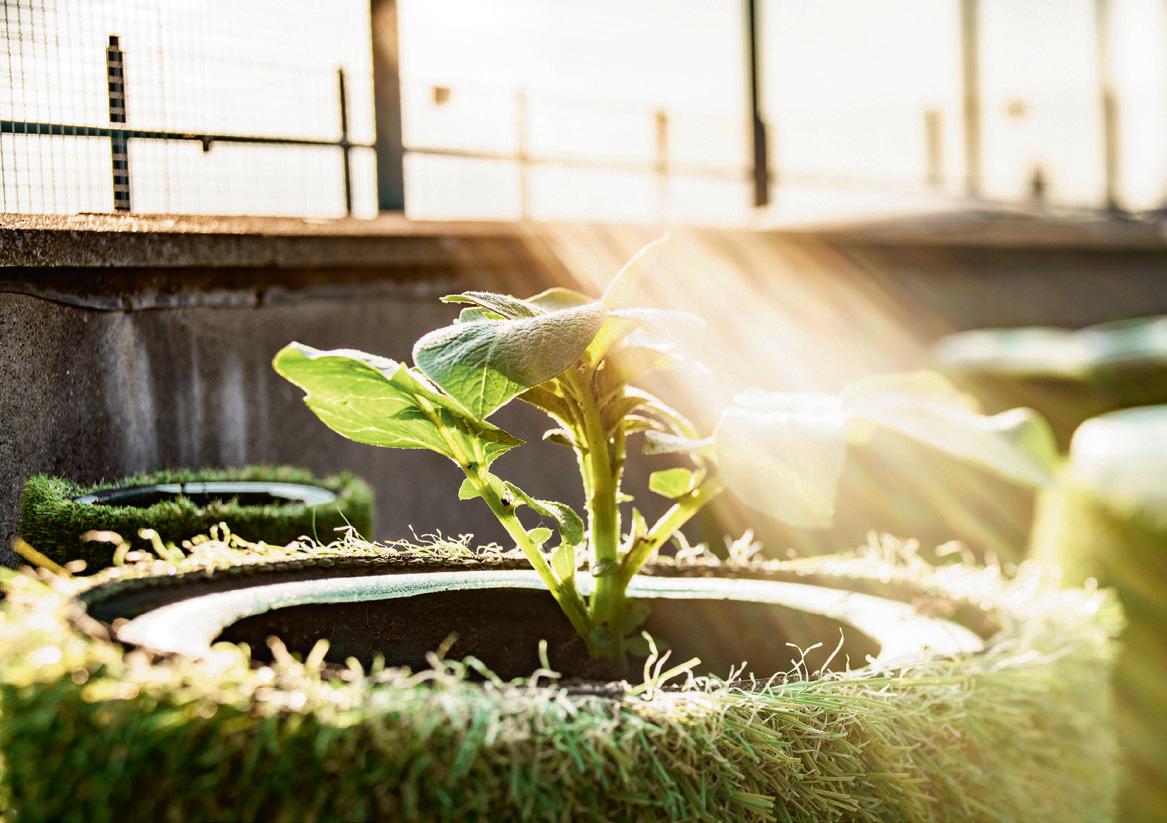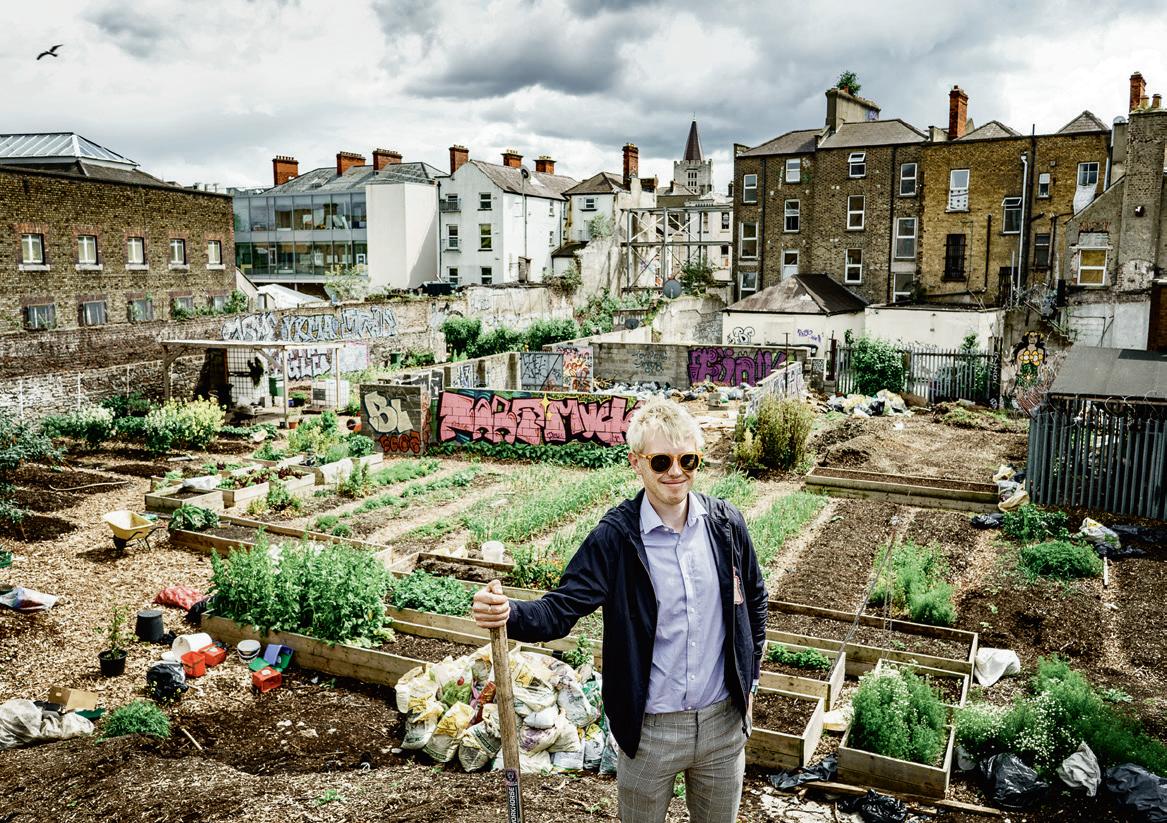
10 minute read
URBAN CULTURE
CONCRETE UTOPIA Andrew Douglas in the Belvedere College greenhouse.
ON THE TOP FLOOR OF BELVEDERE COLLEGE, ONE OF THE IRISH CAPITAL’S MOST RESPECTED SCHOOLS, Andrew Douglas slips a white coat over his pirate’s-head t-shirt, turns on the lights of this vast glass room, and begins inspecting the plants growing here – beetroot, potatoes, radishes, lettuce, parsley. “We usually think agriculture happens outside the city,” he says. “But an urban setting can also be conducive to food farming.” This energetic, enthusiastic forty-something man introduced the first urban farm in Dublin in 2012, initially setting up shop on the roof of an old factory. Across this 400-square-metre space, he grew vegetables, raised chickens and kept a few hives, before having to move in 2014 to make way for the city’s new urban projects. A few months later, in January 2015, Belvedere College offered him this greenhouse, home to both high-tech and low-tech paraphernalia. “It’s a laboratory,” he says. “We work with high school students to experiment with different techniques for growing in small spaces. We test alternatives to chemical and industrial agriculture. We imagine what the city of tomorrow might look
like.” On one side, rows of above-ground crops sit above basins holding swimming grey fish: tilapia. “It is a closed circuit: the basin water irrigates and feeds the plants, which filter the water before sending it back, clean, to the basin.” Nearby, a line of planters holds growing mushrooms: “We collect coffee grounds from around the neighbourhood to use as compost. In the space of a month, using ten kilos of grounds, we produce three kilos of mushrooms. There’s huge potential there. To give you an idea of the quantities available, every coffee shop on this street throws away around 40 kilos of grounds a week.” The approach that Andrew promotes is at once scientific, ecological and socially responsible: it intends to show that an urban farm can be productive, innovative and sustainable, while helping forge stronger ties between residents. “These new farms are designed to blend into their urban environ-

RECYCLING Coffee grounds, a natural mushroom fertiliser.


ment,” he continues. “We recycle a number of staple articles, using them to locally produce high-quality foods.” The initiative championed by this green-thumbed urbanite is part of a broader movement, one that is drawing a growing number of followers in Dublin and many other cities in Europe and around the world, as urban populations swiftly swell. Douglas, a cycling enthusiast and professional sound engineer, is starting to achieve what was, a few years ago, still considered utopian: turning the city into a food-production platform.
“NEW LIMITATIONS”
“Our governments generally promote industrial agriculture, monoculture and achieving new productivity records, but they forget that we’re in the midst of a climate crisis”, explains artist Zack Denfeld, Founder of CoClimate, a think-tank specialising in climate issues. “So we must review the agricultural model that’s based on oil dependency, right? We have to reduce energy waste, consider renewable energy sources, favour local foods.” In the spring of 2016, this visionary jack-of-all-trades was one of the curators of the “Field Test” exhibition, funded by the venerable Trinity College, exploring innovations to make the farm of tomorrow a reality. Sitting in the Science Gallery cafeteria on the campus of the elite university founded in the 16th century, the young man takes his question further: “How can we adapt the farm to fit these new limitations, when more than 60% of the Irish population lives in the city and only 1% of our crops are certified organic? These are the questions we address in the exhibition.”
After World War II, like nearly all the world’s countries, the island shifted from family farming – fairly diverse and mostly in keeping with nature’s biodiversity balance – to productivist agriculture, across larger expanses of land. In 1973, when the Republic of Ireland joined the European Union, the concentration of farms accelerated further still: “The Irish’s ties to the land began to slacken; then the Eighties saw the arrival of the supermarket culture,” explains Nathan Jackson, one of the first farmers on the outskirts of Dublin to propose Community-Supported Agriculture (CSA*) in the town of



TEAM SPIRIT Jason Sheridan, gardener for the northern quarters.
PIONEERS The Food Co-op has been selling organic vegetables since 1983.
Celbridge. When the 29-year-old began his farming operations, he was surprised by the enthusiastic response to his organic courgettes, carrots, garlic and apples: “Consumers are much choosier about what they eat today. And that’s a good sign!”
ROOFTOPS
A bumper crop of urban-farming initiatives is thriving across the city. Perhaps the oldest is the Dublin Food Co-op, a consumer group focused on vegetarian and organic food. “The cooperative was founded in 1983,” recalls its General Manager, Norman Rides. “Initially, most goods had to be imported. But, bit by bit, we managed to produce locally. We now have 1,700 members, some of whom grow their own crops in their gardens.” Of similar ilk, Michael Kelly started the Grow It Yourself (GIY) movement in 2009. The objective was to “support individuals wanting to grow their fruits and vegetables,” reports the former IT consultant who managed to expand the GIY movement to some 80 cities and towns in Ireland. The training sessions held every month, showing just how to cultivate on one’s own plot, attract interested gardeners-to-be of all ages. “Word-of-mouth is doing its job; more and more people come each time,” enthuses Michael.
In the lively Temple Bar district, Pádraic Óg Gallagher runs the Boxty House restaurant, where he cooks potatoes to make the Irish boxty, or potato pancake. This is also the headquarters of the Thank Potato fk group, founded in 2001 by this renowned restaurateur to bring potato farming into the urban environment: “A good portion of those we cook come from Dublin proper. I’m growing some in front of my windows and on a few rooftops, like at Belvedere College with Andrew Douglas. We produce more than 120 varieties. And this is just the beginning – there are so many possibilities! Take time to
Aspiring green thumbs of all ages want to learn how to help their plots flourish.

URBAN INTEGRATION “Thank Potato” spuds are grown on the rooftops.
look at Dublin on Google Maps and you’ll see all those flat roofs that could be converted into vegetable gardens!” This past June 2016, Pádraic was delighted to attend the second annual Bloom Fringe Festival, promoting the city’s community gardens and informing residents about alternatives to the supermarket. “This festival grew out of citizens’ desire to reclaim public spaces. It promotes a form of ‘guerrilla’ vegetable farming, encouraging people to grow vegetables on abandoned land.”
LOOKING TO THE FUTURE
“Everyone can do it,” says Jason Sheridan, who grows peas, broccoli, artichokes, carrots, leeks, potatoes and onions at the foot of his red-brick building in the north of the city. “It was the high price of organic vegetables that prompted me to get my hands dirty,” says this solid man in his thirties with a degree in sociology. Five years ago, he collaborated with a few neighbours to make large wooden planters in some of the city’s public spaces he’d known while growing up, to hold the soil where the first seeds would be planted. “We did everything ourselves, without asking anyone. But we didn’t expect it to forge such team spirit – the youngest in the group is age eight; the oldest is 80.”
Further south, in the Liberties district, on the other side of the River Liffey, an imposing dome embodies a futuristic vision for the city. “It’s a plastic-covered wooden frame,” explains thirty-something Niall O’Brien, the man behind the Grow Dome Project. In this unusual glasshouse resembling a translucent igloo, vegetables are grown hydroponically, meaning aboveground. “After the economic recession hit Dublin in 2008, many fields were left fallow,” Niall continues. “We created the first dome on one of these plots in 2014. It’s a strange-looking structure that serves as a neighbourhood landmark. Today, 150 volunteers take turns tending the crops in the dome or in the garden around it.” It’s now a proven model and, this
SHARED GARDEN Graphic designer Rian Coulter in the vegetable garden at the National College of Art and Design.
winter, another dome will be built on the campus of Dublin City University in the neighbourhood of Glasnevin. “And two other projects are underway, as well” exclaims Niall, who dreams of building domes across all of Dublin. “Why not? It would be a first step toward food self-sufficiency.”
Just a few blocks away, students at the National College of Art and Design have also created their own vegetable garden. “There was this empty lot adjacent to our premises,” reports Rian Coulter, a former student who today is a graphic designer. “In 2013, we created a community garden with people from the neighbourhood.” On this one-hectare plot, enclosed by graffiti-tagged walls, young people now cultivate rows of lettuce, spinach and potatoes. Part of the plot is used to make compost, an essential ingredient for adding nutrients to the soil, making it more fertile. “Everything starts with the compost,” asserts Tony Lowth, a professional gardener who now helps the students with this project. “It’s really the foundation of natural farming. We make it using vegetable waste, coffee grounds and horse manure from the horses that take tourists around the city in carriages – the stables are right next door. Today, we have so much compost that we can sell the excess.” The man points to the towering

The students grow lettuce, potatoes, spinach and more.
soil pile four metres behind him, before concluding categorically, “This is the future of Dublin’s urban farms. This garden is my bank vault – and I have much more faith in it than I do a bank.” n
* CSA: Community-Supported Agriculture. Generally involves producing high-quality foods for a local community, often via organic or biodynamic farming methods, and a shared-risk membership and marketing structure. Consumers and other stakeholders are heavily involved, creating a stronger consumer-producer relationship. The locals pay in advance for their consumption of the foods for a designated period, giving the farmer greater financial security and forecasting ability. The system varies widely in terms of how the farm budget is supported by consumers and how producers then deliver the foods.


MEET THE NEW URBAN FARMERS
“There are now so many citizen initiatives in every realm of urban agriculture in Dublin that we’ve actually put together guided tours.” In the spring of 2016, Andrew Douglas, Belvedere College’s experimental farmer, began organising bike outings to give residents (and tourists) the chance to meet the city’s new generation of farmers. It’s also an opportunity to learn about the Brewtonic association and its unusual collective-beer project. The concept entails letting a number of Dubliners grow hops in their gardens, then harvesting their crops to make a special beer in autumn 2016. “It’s a fun way to get the city’s citizens interested in local, artisanal initiatives,” explains Conor Dunne, the young man in his thirties who is behind the project, before returning to his task of hoeing his hop plants (see photo opposite) and herbs on the roof of The Bernard Shaw fl pub, near St Stephen’s Green. On the terrace of Grogans, a pub with a deep-red façade on South William Street, architect Gearóid Carvill and photographer Kieran Harnett talk about another original initiative: the Dublin Honey Project. “Dublin has everything it could possibly need to produce its own honey,” they report. “We’re now maintaining hives in the city’s 24 boroughs.” For now, thirty of them are set in four main neighbourhoods: “The last harvest produced 500 kilos of honey,” states Gearóid. But why in the city instead of the country? “The fact is, in urban environments, there’s greater diversity than in the countryside, where many areas are taken over by monocultures. And we use far fewer pesticides on the plants, which means better honey in the end.”










